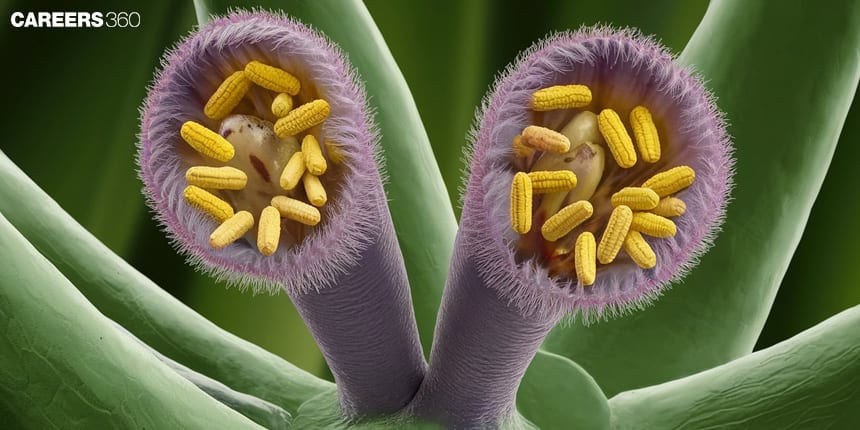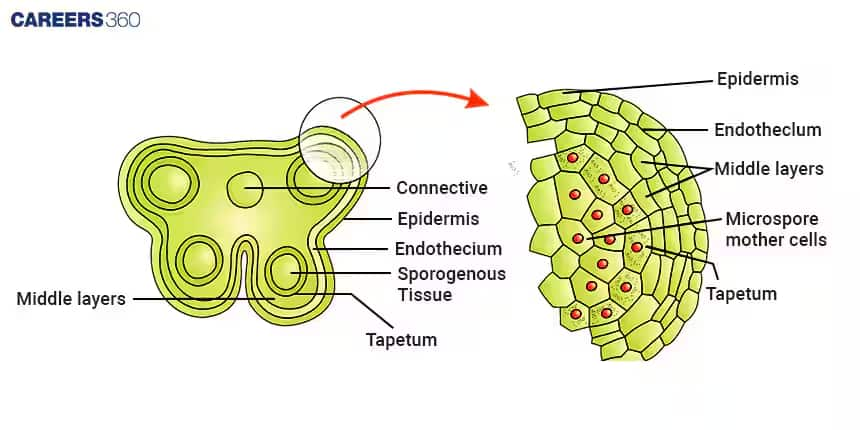Bilobed Anther
The bilobed anther is an important component of the male reproductive part of flowering plants as it produces and dehisces the pollen grains. This topic is explained under the Class 12 chapter Sexual Reproduction in Flowering Plants of Biology. Questions may appear in competitive exams like NEET about the structure of an anther, diagrammatic representation and related concepts like microsporangia and pollen formation.
NEET 2025: Mock Test Series | Syllabus | High Scoring Topics | PYQs
NEET Important PYQ's Subject wise: Physics | Chemistry | Biology
New: Meet Careers360 B.Tech/NEET Experts in your City | Book your Seat now
- Definition of Anther
- Structure of an Anther
- Microsporangia
- Bilobed Nature of Anther

Definition of Anther
The anther belongs to the stamen and is the organ for the production and storage of pollen grains in flowering plants. In this light, anthers are concerned with pollen transfer from one flower to another and, in turn, fertilisation in plant reproduction. In this regard, one bilobed anther structure with two distinct lobes, each lobe containing pollen sacs, is quite important in its efficiency for pollen release. This structure allows for maximum dispersal of pollen grains and thus offers a chance for successful pollination and an increase in the genetic diversity of plants.
Structure of an Anther
The structure of the anther is described below-

Anther and its Parts
The anther is that part of the stamen that bears pollen, and it is usually bilobed with two pollen sacs or microsporangia within each lobe.
Two lobes of Anther
Within an anther, two lobes are connected using a connective tissue; each lobe is further subdivided into two microsporangia.
Epidermis
It is the outer protective layer of the anther that protects the inner tissues from the harsh conditions of the environment.
Endothecium
This layer is just inside the epidermis, which supplies the force for anther dehiscence or opening, hence releasing the pollen.
Middle layers
It consists of a few layers of cells which help in providing structure support and also participate in the maturation of anther.
Tapetum
This is the innermost single layer lining the anther wall that supplies nutrition to the developing pollen grains.
Also Read:
Microsporangia
Microsporangia are the pollen sacs in the anther, inside which microsporogenesis takes place for the formulation of microspores.
Development of microspores
Microsporogenesis - the process in which a diploid microsporocyte undergoes meiosis to yield haploid microspores.
Bilobed Nature of Anther
By bilobed structure, it means an anther that is divisional into two distinct lobes, wherein each of these lobes contains two microsporangia.

Importance of bilobed structure in pollen release
The above structure is specifically designed to let the pollen grains disperse from the anther for fertilisation.
Thecae
These anther lobes are further divided into two thecae, which act as the chambers for storing pollen.
Function and significance in pollen storage
The thecae will ensure the pollen is kept safe up to when it would have matured to be dispersed.
Connective Tissue
Connective tissue forms the centre of the anther, joining the two lobes together and containing vascular tissues that feed the anther.
Also Read:
Recommended Video on 'Bilobed Anther'
Frequently Asked Questions (FAQs)
An anther is diploid (2n) in structure, along with the plant itself.
Emasculation is the removal of stamens from the female parents' bisexual flowers in order to prevent self-pollination. It is done before the anthers are mature.
No, an anther is a male gamete-producing body, so unless the flower is not bisexual or male, it lacks an anther.
Yes, both the anther and the ovary must be present in the same flower, or at least in different flowers of the same plant, to achieve self-pollination.
Removing the anthers before they dehisce will result in the death of both the anthers and the pollen within them. It is a practice that is used to prevent self-pollination.
Also Read
29 Nov'24 01:36 PM
18 Oct'24 04:39 PM
19 Sep'24 11:47 AM
19 Sep'24 11:02 AM
18 Sep'24 06:54 PM
18 Sep'24 06:14 PM
30 Aug'24 10:07 AM
30 Aug'24 06:20 AM

